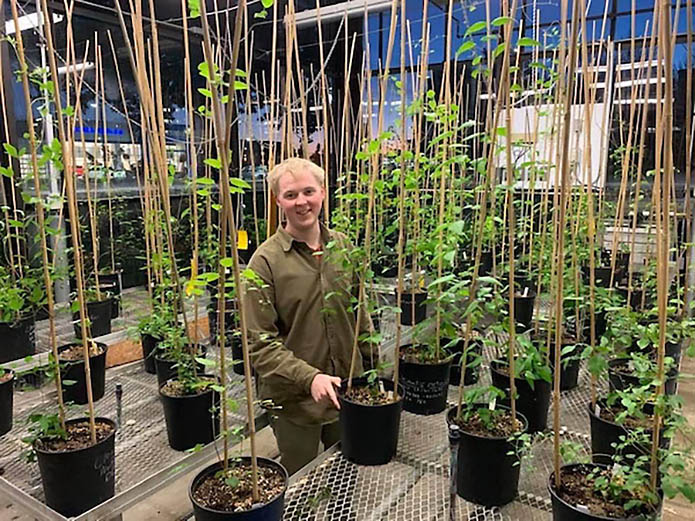 Clarksville, TN – While working as a graduate research assistant with Austin Peay State University’s Center of Excellence for Field Biology and the Southeastern Grasslands Institute, Thomas Murphy identified four new species of Clematis and one species that had been forgotten for more than a century.
Clarksville, TN – While working as a graduate research assistant with Austin Peay State University’s Center of Excellence for Field Biology and the Southeastern Grasslands Institute, Thomas Murphy identified four new species of Clematis and one species that had been forgotten for more than a century.
He did this through a form of scientific gardening in conjunction with observations of herbarium specimens, fieldwork, and collaborations with Jesse Harris from the University of Colorado – Boulder who provided DNA analysis.
What most people don’t realize is that there are over 20 different species of Clematis native to the southeastern U.S. These species look very different from the large-flowered vine that is so familiar in the gardening world. In fact, most of the region’s native Clematis species are not available within the traditional horticultural industry, although some can be found through native plant nurseries.
One of the Clematis species native to the southeastern U.S. is netleaf leatherflower (Clematis reticulata). It’s range covers Tennessee west to Oklahoma, and south to Texas and Florida. However, the plant was known to be highly variable across its range.
Some botanists thought this variability represented different species. Others thought the variability was due to differences in the climate, geography and other conditions where the plants were found. Murphy’s research, which was funded by the prestigious Mt Cuba Center Graduate Fellowship in Eastern American Botany, sought to discover the answer to this long-standing scientific mystery.
“At Mt. Cuba Center we are committed to conserving native plants in the wild, in our gardens, and in the hearts of our guests and students,” said Amy Highland, Mt. Cuba Center’s Director of Collections and Conservation Lead. “This study demonstrates how botanical research can discover new species in unexpected places. Learning more about these plants helps us to determine how to best protect them.”
Murphy began his research by examining dried herbarium specimens of netleaf leatherflower from across its range. This is the method that had been most often used by previous taxonomists investigating the variability of netleaf leatherflower. However, he quickly realized that many of the herbarium specimens only contained a portion of the vine and in some cases important characteristics of the plants had been obscured or lost in the pressing and drying processes.
In order to truly understand and categorize the variations, Murphy realized that he needed to see the plants growing in their natural environments. So, he and his colleagues took to the field, driving over 15,000 miles across more than 20 states.
“When I started seeing the different populations of netleaf leatherflower in the field is when it really started to strike me,” Murphy said. “Everything about these populations seemed different – the way they looked, their habitats, the associated species, just everything.”
At each site, Murphy collected and processed new herbarium specimens showing the entire plant. He also collected leaves for DNA analysis by Harris. Murphy, then took his research one step further and did something no one else had done with this species – he conducted what is known as a common garden experiment.
With appropriate permits to do so, he collected two living transplants from each site. One of these plants he grew in APSU’s greenhouse and the other was sent to the Mt. Cuba Center in Delaware. Both of these sites now provide living collections of all the Clematis in Murphy’s study.
By growing the plants together in a greenhouse, Murphy was able to ensure that all of the environmental factors the plants experienced were the same. If the variations were simply due to environmental factors like climate or soil nutrition, then the variations should have disappeared when the plants were grown under the same conditions. That didn’t happen.
“Through this collaboration, Mt. Cuba Center has brought together a living collection of Clematis,” Highland said. “This allows us to compare morphological differences in a way not possible through traditional herbarium specimens. Seeing plants in three dimensions and in a common environment allows us to make comparisons and observe differences that have previously eluded botanists.”
Just as exciting, Harris’ DNA analysis of the leaves that Murphy and his colleagues collected also indicated that they came from genetically different species. All of the evidence pointed to the same conclusion – the variability of netleaf leatherflower was a result of it being multiple species instead of just one.
“It was very exciting to see DNA results that aligned with morphological and ecological evidence to paint a clearer picture for southeastern Clematis,” said Harris. “And identifying this biodiversity is only the beginning of the story for southeastern Clematis.
“Now that we know we are working with different species, we are able to unlock all kinds of amazing new questions that drive our exploration of evolutionary and ecological processes. Those questions and explorations will help us to more effectively protect these species that have flown under the radar for so long,” continued Harris.
In an article published recently in the scientific journal Systematic Botany, Murphy and his co-authors split netleaf leatherflower into six species – the original netleaf leatherflower species which is found mostly in the Deep South pinelands, a previously described species most common across northern Alabama that had been forgotten for over a century, and four completely new species from other parts of the Southeast. Several of the species identified have highly restricted ranges and may warrant state and/or federal protection.
“One of the newly described Clematis species is only found in two places on Pine Mountain in Georgia,” Dr. Dwayne Estes, APSU professor of biology, said. “That’s two places in the entire world with a combined estimated population of probably around 150 individuals – all of which live in a fire-dependent ecosystem that is part of a globally imperiled Mountain Longleaf Pine Woodland natural community.”
Estes, a co-author on the paper, mentored Murphy’s research. In addition to being a professor, Estes is a principal investigator in APSU’s Center of Excellence for Field Biology and a co-founder and the executive director of the Southeastern Grasslands Institute.
“Research like this is important because it’s impossible to know what we need to conserve, if we don’t know it is there,” Murphy said. “As the current biodiversity crisis accelerates and funding for descriptive research evaporates, we risk losing species before we have the chance to know, understand, and conserve them.”
Murphy is currently pursuing his Ph.D. at the University of Florida, where he is studying plant systematics of neotropical Smilax. Funding for Murphy’s Clematis research was provided by the Mt. Cuba Center, the British Clematis Society, and a private donor.
Read the journal article at: Systematic Botany 47(3):667-690 (2022). https://doi.org/10.1600/036364422X16573019348210



